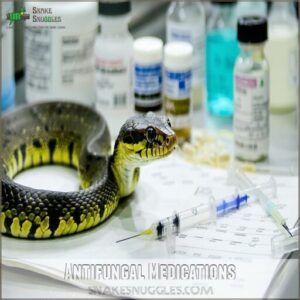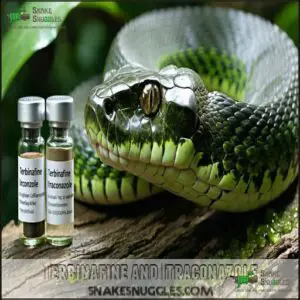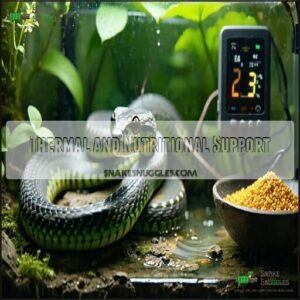This site is supported by our readers. We may earn a commission, at no cost to you, if you purchase through links.
 For safe snake fungal infection treatment, you’ll need to act quickly with antifungal medications like terbinafine or itraconazole prescribed by a reptile veterinarian.
For safe snake fungal infection treatment, you’ll need to act quickly with antifungal medications like terbinafine or itraconazole prescribed by a reptile veterinarian.
Keep your slithery patient in quarantine with ideal temperature and humidity levels to support recovery. Clean the enclosure thoroughly with veterinary-approved disinfectants to prevent reinfection.
You’ll need to carefully apply topical treatments to affected areas and possibly administer oral medications. Like nursing a cold, consistency is key—maintain proper nutrition and hydration throughout treatment.
Advanced cases might require debridement of necrotic tissue under veterinary supervision. The difference between successful treatment and complications often comes down to environmental management techniques, which are crucial for recovery.
Table Of Contents
- Key Takeaways
- Snake Fungal Disease Causes
- Symptoms and Diagnosis
- Treatment Options Available
- Managing Disease Spread
- Effective Treatment Strategies
- Frequently Asked Questions (FAQs)
- What kills snake fungal disease?
- How do you treat fungal infection in reptiles?
- What is the mortality rate for snake fungal disease?
- What is the fastest way to cure a fungal infection?
- How long do treatment protocols typically last?
- Can snakes develop resistance to antifungal treatments?
- Are there preventative supplements for captive snakes?
- What are recovery chances for advanced cases?
- How often should treated snakes be reassessed?
- Conclusion
Key Takeaways
- You’ll need to act quickly with antifungal medications like terbinafine or itraconazole prescribed by a reptile veterinarian, as early intervention substantially improves recovery outcomes.
- Keep your infected snake in quarantine with proper temperature and humidity levels while thoroughly cleaning the enclosure with approved disinfectants to prevent reinfection.
- You should combine medical treatments with supportive care including proper nutrition and hydration, as this comprehensive approach gives your snake the best chance at fighting the infection.
- You must maintain strict biosecurity practices, using 3% bleach solution to disinfect all equipment and preventing soil transfer between habitats to stop the spread of this persistent fungal pathogen.
Snake Fungal Disease Causes
Snake Fungal Disease is caused by the fungus Ophidiomyces ophiodiicola, which thrives in soil and organic debris.
It spreads to snakes through environmental contamination and, in some cases, possibly direct contact.
Ophidiomyces Ophiodiicola Fungus
Ophidiomyces ophiodiicola, the culprit behind snake fungal disease, thrives in diverse habitats due to its remarkable environmental persistence and genetic variability.
This fungus, belonging to Onygenacea, produces virulence factors that weaken snake immunity.
Its global distribution underscores the urgent need for antifungal snake treatment. Mortality can reach 40% in affected populations.
Understanding Ophidiomyces’ taxonomy is essential for developing safe reptile antifungal strategies to protect vulnerable species and ecosystems.
Environmental Contamination
Environmental contamination plays a significant role in snake fungal infection outbreaks.
Soil persistence of the fungus means spores linger in habitats, increasing habitat risk for snakes.
Human vectors, like shoes or tools, can unintentionally spread fungal dissemination.
Decontamination methods such as cleaning gear with bleach or ethanol help reduce risks.
Prevention guarantees safer reptile habitats and enhances antifungal snake treatment effectiveness.
Snake to Snake Transmission
While soil contamination plays a big role in snake fungal infection, you might wonder about direct contact between snakes.
Although horizontal spread through shared dens is rare, it’s not impossible. Transmission mechanisms also include possible vertical transmission, where infection passes from mother to offspring.
Pathogen transmission within species remains complex, with disease spread relying more on environment than direct interaction.
Key points to remember:
- Shared dens increase exposure risk.
- Vertical transmission may occur.
- Horizontal transmission is uncommon.
Symptoms and Diagnosis
When you spot facial swelling, crusty skin, or unusual nodules on a snake, these could point to Snake Fungal Disease (SFD).
Diagnosing SFD often involves examining these symptoms and confirming the fungus through lab tests like cultures or DNA analysis.
Facial Swelling and Lesions
Facial swelling is a hallmark of snake fungal infection symptoms, often accompanied by painful skin lesions that worsen without intervention.
These can cause feeding difficulties and vision impairment, increasing the risk of secondary infections.
Effective antifungal treatment and pain management are essential to reduce scarring effects and improve recovery.
Left untreated, these snake skin infections can severely impact survival and overall health.
Skin Ulcerations and Nodules
Skin ulcerations and nodules aren’t just cosmetic issues—they can spotlight how far snake fungal disease has advanced.
Ulceration severity often depends on lesion morphology and nodule location, showing tissue swelling and skin discoloration. These skin lesions may feel crusty or thick.
Early monitoring and antifungal treatment can help manage symptoms, minimizing damage before nodules complicate a snake’s overall health.
Environmental factors like improper humidity levels can also contribute to these conditions, which can be considered a critical issue for the snake’s health, and may lead to severe damage.
Eye Infections and Pneumonia
Beyond the skin, snake fungal disease can devastate your reptile’s respiratory system and eyes.
As the infection progresses internally, you’ll notice these serious complications:
- Ocular granulomas causing cloudy eyes and possible blindness
- Respiratory distress with labored breathing and wheezing
- Systemic infections spreading to essential organs
- Fatal complications when pneumonia develops
Treatment challenges increase once these symptoms appear, making early antifungal treatment essential for maintaining snake health, and preventing fatal complications when pneumonia develops.
Treatment Options Available
You’ll find several effective treatment options for snake fungal infections, including antifungal medications like terbinafine and itraconazole that target the Ophidiomyces ophiodiicola fungus.
Combining medical interventions with proper thermal and nutritional support gives your scaly companion the best chance for recovery, though success rates vary among different snake species.
Antifungal Medications
Once symptoms are diagnosed, treating snake fungal disease typically involves antifungal medications as the first line of defense.
You’ll find several options available, though their effectiveness varies substantially between snake species. To explore available options, you might want to research medications for snakes.
| Antifungal Type | Common Side-Effects | Treatment Duration |
|---|---|---|
| Azoles | Liver stress, reduced appetite | 2-3 months |
| Allylamines | Skin irritation, lethargy | 1-2 months |
| Polyenes | Kidney issues, dehydration | 3-4 weeks |
Drug resistance remains a challenge, requiring careful dosage optimization throughout the antifungal therapy to address potential issues like liver stress and ensure effective treatment.
Terbinafine and Itraconazole
Among specific antifungal medications, Terbinafine and Itraconazole offer promising options.
Terbinafine efficacy shows in its fungicidal action, while Itraconazole works fungistically.
You’ll find treatment duration varies based on species variations, with combination antifungal therapy often yielding better results than single-drug approaches.
When treating your snake, watch for potential drug interactions and Itraconazole resistance.
Continuous treatment regimens typically outperform pulsed ones, with some studies showing complete resolution within 28 days of proper antifungal treatment.
Thermal and Nutritional Support
Consistently, thermal and nutritional support forms the backbone of effective snake fungal disease treatment.
You’ll need to maintain proper temperature regulation to boost your snake’s immune response while implementing hydration strategies for recovery.
Provide easily digestible foods to meet dietary needs and use appetite stimulation techniques for reluctant eaters.
This supportive care approach, when combined with medication, gives your reptile the best chance at fighting infection.
Adequate reptile habitat warmth is essential for effective recovery and should be considered a crucial part of the treatment plan, ensuring the best chance at overcoming the infection with proper immune response.
Managing Disease Spread
You’ll need to prevent Ophidiomyces ophiodiicola transmission by quarantining infected snakes and disinfecting all equipment with 3% bleach solution before handling healthy specimens.
Your consistent biosecurity practices, including avoiding soil transfer between habitats, will substantially reduce the risk of spreading this persistent fungal pathogen that can remain viable in environmental substrates for extended periods.
Quarantine and Isolation
Four isolation protocols must be implemented immediately upon detecting snake fungal disease in your collection.
Proper quarantine duration of at least 90 days prevents the silent spread of this devastating reptile fungal disease to healthy specimens.
Optimal environmental conditions are also essential during this period.
- Your heart will break seeing formerly vibrant reptiles struggling with painful lesions
- You’ll feel overwhelming relief when quarantine prevents facility-wide outbreaks
- The satisfaction of seeing a recovered snake return to normal behavior is priceless
- Anxiety turns to confidence as you master safe handling techniques
- Pride swells knowing your careful isolation saved your beloved collection
Use dedicated tools and disposable gloves for preventing spread between enclosures during snake care.
Environmental Decontamination
While keeping infected snakes isolated, don’t overlook your environment.
Proper soil treatment is essential—fungal spores can persist for months. Clean all equipment with 3% bleach or 70% ethanol for at least 2 minutes to kill Ophidiomyces ophiodiicola.
Don’t track contaminated soil between habitats. UV sterilization works for small areas, while bioremediation and habitat restoration are long-term solutions.
Consider using a suitable cleaning agent for thorough disinfection. Environmental hygiene isn’t just good practice—it’s life-saving for vulnerable snake populations.
Public Awareness and Education
Public awareness serves as our first line of defense against snake fungal disease spread.
You can join community outreach programs and citizen science initiatives by reporting sightings of infected snakes.
Educational resources about preventative measures are available through wildlife agencies and herpetology groups.
Learning snake care tips helps identify early snake health issues, while understanding snake fungal infection prevention protects both captive and wild populations.
Effective Treatment Strategies
You’ll need to act quickly when you spot the telltale facial swelling or crusty lesions of snake fungal disease, as early intervention substantially improves recovery outcomes.
Your treatment approach should combine appropriate antifungal medications like terbinafine with supportive care suited to your snake’s species, as treatment success varies widely among different snake types.
Early Detection and Intervention
With proper management practices in place, early detection becomes your most powerful tool against snake fungal disease.
Spotting skin lesions quickly can mean the difference between successful treatment and losing your snake.
Rapid diagnostics allow for immediate antifungal treatment before infections become systemic.
Experienced keepers implement preventative measures through regular health checks, partnering with veterinarians on fungal diagnostics.
Laboratory confirmation methods are essential for accurate diagnoses.
Population monitoring and proper intervention timing, supported by collaborative research, substantially improves survival rates.
Proper management and regular health checks are crucial in the fight against snake fungal disease, and with the right approach, you can significantly improve the chances of successful treatment and recovery.
Species-Specific Treatment Plans
Different snake species respond uniquely to fungal treatments.
Colubrid treatment often fails with standard antifungals, while rattlesnake therapies using terbinafine show better success rates.
Water snake care requires specialized approaches due to their aquatic habits.
Individual variability means your snake’s treatment plan must be customized specifically—what works for an indigo won’t necessarily help a massasauga.
When seeking a reptile fungal infection cure, always consult a snake veterinarian familiar with species-specific dermatology protocols, as this is crucial for effective fungal treatments.
Ongoing Research and Development
Research on snake fungal disease is advancing rapidly.
Scientists are exploring novel antifungals with lower toxicity and investigating genetic resistance in some snake populations.
Vaccine development shows promise, though it’s still in early stages.
Researchers are studying immune response patterns across species while conducting field trials of combination therapies.
Several institutions collaborate on these efforts, including Kennesaw State University with Zoo Atlanta and the Prairie Research Institute’s work with massasauga rattlesnakes in veterinary medicine.
Frequently Asked Questions (FAQs)
What kills snake fungal disease?
Like David battling Goliath, you’ll need antifungals such as terbinafine (via nebulization or implant), itraconazole, or fluconazole.
You can also use surgical removal, topical treatments, 3% bleach disinfection, and supportive care for infected snakes.
How do you treat fungal infection in reptiles?
You’ll need to apply antifungal medications like Terbinafine or itraconazole, either topically or systemically.
Maintain proper temperature and humidity in the enclosure, and clean thoroughly with disinfectants to prevent reinfection or spread.
What is the mortality rate for snake fungal disease?
Snake fungal disease carries a devastating 40% mortality rate.
You’ll notice infected snakes typically survive only 90 days after infection, with some species like the Eastern Massasauga experiencing over 90% mortality in Eastern U.S. populations.
What is the fastest way to cure a fungal infection?
Consult a veterinarian immediately for antifungal treatment. You’ll need terbinafine via implant or nebulization, plus supportive care. Early intervention gives your snake the best fighting chance against this challenging disease.
How long do treatment protocols typically last?
Treatment protocols for snake fungal disease typically last 3-6 months.
You’ll need multiple courses of antifungal medication, with ongoing monitoring as complete resolution isn’t guaranteed.
Patience is essential throughout this lengthy process, as complete resolution of the disease is not certain.
Can snakes develop resistance to antifungal treatments?
With a 40% mortality rate, the possibility exists.
You’ll find O. ophiodiicola can develop resistance to treatments, especially after repeated exposure.
That’s why veterinarians often rotate antifungal medications or use combination therapies for your affected reptiles.
Are there preventative supplements for captive snakes?
You’ll benefit from adding vitamin D3, calcium, and multivitamins to your captive snake’s regimen.
Proper nutrition supports immune function, potentially helping resist fungal infections.
Keep enclosures clean and maintain ideal humidity levels too.
What are recovery chances for advanced cases?
Recovery chances for advanced SFD cases are typically poor, with a 40% mortality rate overall.
You’re facing an uphill battle, but early intervention with proper antifungal treatment can improve your snake’s odds substantially.
How often should treated snakes be reassessed?
Closely monitor your treated snake every 2-3 weeks initially, then monthly as improvement occurs. You’ll need visual inspections and possibly lab tests to track the fungal infection’s response to treatment.
Conclusion
From prevention to treatment, your vigilance is the first line of defense in safe snake fungal infection treatment.
You’ll need to combine veterinary care with proper husbandry—maintaining ideal environmental conditions while following medication protocols precisely.
Remember, early intervention dramatically improves outcomes.
By understanding the causes, recognizing symptoms quickly, and implementing thorough treatment strategies, you’re giving your reptilian companion the best chance at a full recovery.
Don’t wait to act if you notice suspicious lesions or behavioral changes, as proper husbandry is crucial in these situations.















